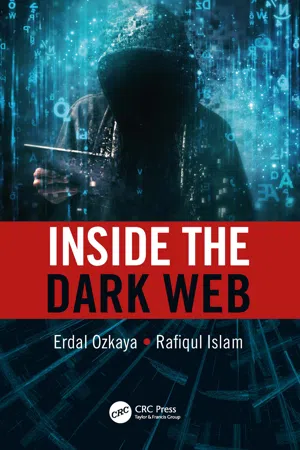
- 266 pages
- English
- ePUB (mobile friendly)
- Available on iOS & Android
Inside the Dark Web
About this book
Inside the Dark Web provides a broad overview of emerging digital threats and computer crimes, with an emphasis on cyberstalking, hacktivism, fraud and identity theft, and attacks on critical infrastructure. The book also analyzes the online underground economy and digital currencies and cybercrime on the dark web. The book further explores how dark web crimes are conducted on the surface web in new mediums, such as the Internet of Things (IoT) and peer-to-peer file sharing systems as well as dark web forensics and mitigating techniques.
This book starts with the fundamentals of the dark web along with explaining its threat landscape. The book then introduces the Tor browser, which is used to access the dark web ecosystem. The book continues to take a deep dive into cybersecurity criminal activities in the dark net and analyzes the malpractices used to secure your system. Furthermore, the book digs deeper into the forensics of dark web, web content analysis, threat intelligence, IoT, crypto market, and cryptocurrencies. This book is a comprehensive guide for those who want to understand the dark web quickly.
After reading Inside the Dark Web, you'll understand
- The core concepts of the dark web.
- The different theoretical and cross-disciplinary approaches of the dark web and its evolution in the context of emerging crime threats.
- The forms of cybercriminal activity through the dark web and the technological and "social engineering" methods used to undertake such crimes.
- The behavior and role of offenders and victims in the dark web and analyze and assess the impact of cybercrime and the effectiveness of their mitigating techniques on the various domains.
- How to mitigate cyberattacks happening through the dark web.
- The dark web ecosystem with cutting edge areas like IoT, forensics, and threat intelligence and so on.
- The dark web-related research and applications and up-to-date on the latest technologies and research findings in this area.
For all present and aspiring cybersecurity professionals who want to upgrade their skills by understanding the concepts of the dark web, Inside the Dark Web is their one-stop guide to understanding the dark web and building a cybersecurity plan.
Frequently asked questions
- Essential is ideal for learners and professionals who enjoy exploring a wide range of subjects. Access the Essential Library with 800,000+ trusted titles and best-sellers across business, personal growth, and the humanities. Includes unlimited reading time and Standard Read Aloud voice.
- Complete: Perfect for advanced learners and researchers needing full, unrestricted access. Unlock 1.4M+ books across hundreds of subjects, including academic and specialized titles. The Complete Plan also includes advanced features like Premium Read Aloud and Research Assistant.
Please note we cannot support devices running on iOS 13 and Android 7 or earlier. Learn more about using the app.
Information
Chapter 1
Introduction to Cybersecurity and Dark Web
Introduction
- Explanation of cybersecurity and cybercrime
- Web and its categories
- Dark web and its terminologies
- Origins of dark net
- Dark web software.
Cybersecurity and Cybercrime
Cybersecurity
the collection of tools, policies, guidelines, risk management approaches, actions, training, best practices, assurance and technologies that can be used to protect the cyber environment and organization and user’s assets. Organization and user’s assets include connected computing devices, users, applications, services, telecommunications systems, and the totality of transmitted and/or stored information in the cyber environment. Cybersecurity ensures the attainment and maintenance of the security properties of the organization and user’s assets against relevant security risks in the cyber environment. The security properties include one or more of the following: availability, integrity, and confidentiality.
Cybercrime
Cybercrime is a fast‐growing area of crime. More and more criminals are exploiting the speed, convenience, and anonymity of the Internet to commit a diverse range of criminal activities that know no borders, either physical or virtual

Web and Its Levels
Table of contents
- Cover
- Half Title
- Title Page
- Copyright Page
- Table of Contents
- Acknowledgements
- Authors
- Introduction
- 1 Introduction to Cybersecurity and Dark Web
- 2 Threat Landscape in Dark Net
- 3 Malicious Dark Net—Tor Network
- 4 Malware
- 5 Cybercriminal Activities in Dark Net
- 6 Evolution of the Web and Its Hidden Data
- 7 Dark Web Content Analyzing Techniques
- 8 Extracting Information from Dark Web Contents/Logs
- 9 Dark Web Forensics
- 10 Open Source Intelligence
- 11 Emerging Trends in the Dark Web and Mitigating Techniques
- Index